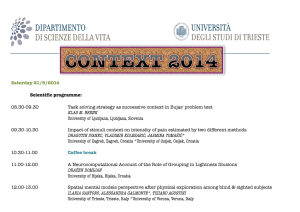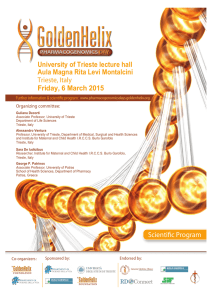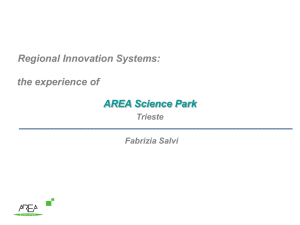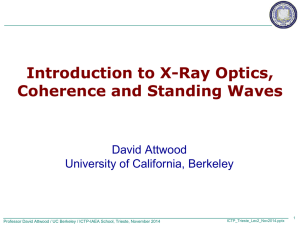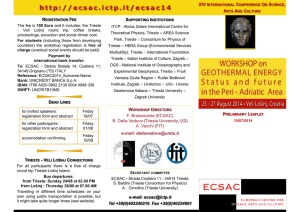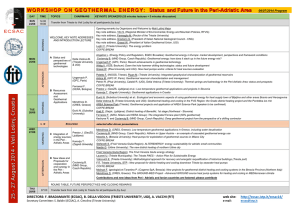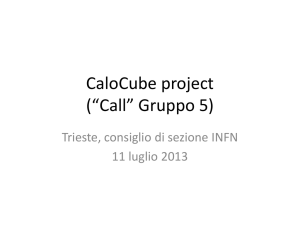ICTP_Attwood_Introduction_to_Synchrotron_Radiation
advertisement
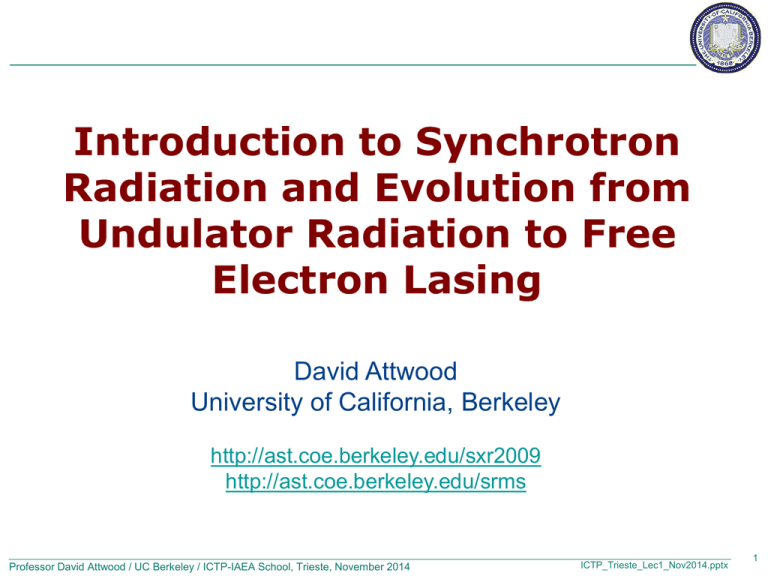
Introduction to Synchrotron Radiation and Evolution from Undulator Radiation to Free Electron Lasing David Attwood University of California, Berkeley http://ast.coe.berkeley.edu/sxr2009 http://ast.coe.berkeley.edu/srms Professor David Attwood / UC Berkeley / ICTP-IAEA School, Trieste, November 2014 ICTP_Trieste_Lec1_Nov2014.pptx 1 Synchrotron radiation Professor David Attwood / UC Berkeley / ICTP-IAEA School, Trieste, November 2014 ICTP_Trieste_Lec1_Nov2014.pptx 2 Synchrotron radiation from relativistic electrons Professor David Attwood / UC Berkeley / ICTP-IAEA School, Trieste, November 2014 ICTP_Trieste_Lec1_Nov2014.pptx 3 Synchrotron radiation in a narrow forward cone Professor David Attwood / UC Berkeley / ICTP-IAEA School, Trieste, November 2014 ICTP_Trieste_Lec1_Nov2014.pptx 4 Three forms of synchrotron radiation Professor David Attwood / UC Berkeley / ICTP-IAEA School, Trieste, November 2014 ICTP_Trieste_Lec1_Nov2014.pptx 5 Bending magnet radiation covers a broad region of the spectrum, including the primary absorption edges of most elements What is Ec at a facility near you? What is 4Ec? Professor David Attwood / UC Berkeley / ICTP-IAEA School, Trieste, November 2014 ICTP_Trieste_Lec1_Nov2014.pptx 6 Wiggler radiation Professor David Attwood / UC Berkeley / ICTP-IAEA School, Trieste, November 2014 ICTP_Trieste_Lec1_Nov2014.pptx 7 Undulator radiation from a small electron beam radiating into a narrow forward cone is very bright Professor David Attwood / UC Berkeley / ICTP-IAEA School, Trieste, November 2014 ICTP_Trieste_Lec1_Nov2014.pptx 8 Undulator radiation Professor David Attwood / UC Berkeley / ICTP-IAEA School, Trieste, November 2014 ICTP_Trieste_Lec1_Nov2014.pptx 9 Calculating Power in the Central Radiation Cone: Using the well known “dipole radiation” formula by transforming to the frame of reference moving with the electrons Professor David Attwood / UC Berkeley / ICTP-IAEA School, Trieste, November 2014 ICTP_Trieste_Lec1_Nov2014.pptx 10 Power in the central cone Professor David Attwood / UC Berkeley / ICTP-IAEA School, Trieste, November 2014 ICTP_Trieste_Lec1_Nov2014.pptx 11 Power in the central radiation cone for three soft x-ray undulators Professor David Attwood / UC Berkeley / ICTP-IAEA School, Trieste, November 2014 ICTP_Trieste_Lec1_Nov2014.pptx 12 Power in the central radiation cone for three hard x-ray undulators Professor David Attwood / UC Berkeley / ICTP-IAEA School, Trieste, November 2014 ICTP_Trieste_Lec1_Nov2014.pptx 13 Ordinary light and laser light Ordinary thermal light source, atoms radiate independently. A pinhole can be used to obtain spatially coherent light, but at a great loss of power. A color filter (or monochromator) can be used to obtain temporally coherent light, also at a great loss of power. Pinhole and spectral filtering can be used to obtain light which is both spatially and temporally coherent but the power will be very small (tiny). All of the laser light is both spatially and temporally coherent*. Arthur Schawlow, “Laser Light”, Sci. Amer. 219, 120 (Sept. 1968) Professor David Attwood / UC Berkeley / ICTP-IAEA School, Trieste, November 2014 ICTP_Trieste_Lec1_Nov2014.pptx 14 Spatially coherent undulator radiation Courtesy of Kris Rosfjord, UCB Professor David Attwood / UC Berkeley / ICTP-IAEA School, Trieste, November 2014 ICTP_Trieste_Lec1_Nov2014.pptx 15 Spatially and spectrally filtered undulator radiation Professor David Attwood / UC Berkeley / ICTP-IAEA School, Trieste, November 2014 ICTP_Trieste_Lec1_Nov2014.pptx 16 Spatial coherence and phase with Young’s double slit interferometer Professor David Attwood / UC Berkeley / ICTP-IAEA School, Trieste, November 2014 ICTP_Trieste_Lec1_Nov2014.pptx 17 Spatial coherence measurements of undulator radiation using Young’s 2-pinhole technique Courtesy of Chang Chang, UC Berkeley and LBNL. l = 13.4 nm, 450 nm diameter pinholes, 1024 x 1024 EUV/CCD at 26 cm ALS, 1.9 GeV, lu = 8 cm, N = 55 Professor David Attwood / UC Berkeley / ICTP-IAEA School, Trieste, November 2014 ICTP_Trieste_Lec1_Nov2014.pptx 18 Spatial coherence measurements of undulator radiation using Young’s 2-pinhole technique Courtesy of Chang Chang, UC Berkeley and LBNL. l = 13.4 nm, 450 nm diameter pinholes, 1024 x 1024 EUV/CCD at 26 cm ALS, 1.9 GeV, lu = 8 cm, N = 55 Professor David Attwood / UC Berkeley / ICTP-IAEA School, Trieste, November 2014 ICTP_Trieste_Lec1_Nov2014.pptx 19 Coherent power at the ALS Professor David Attwood / UC Berkeley / ICTP-IAEA School, Trieste, November 2014 ICTP_Trieste_Lec1_Nov2014.pptx 20 Coherent power at SPring-8 Professor David Attwood / UC Berkeley / ICTP-IAEA School, Trieste, November 2014 ICTP_Trieste_Lec1_Nov2014.pptx 21 Third generation synchrotron facilities Professor David Attwood / UC Berkeley / ICTP-IAEA School, Trieste, November 2014 ICTP_Trieste_Lec1_Nov2014.pptx 22 Ordinary light and laser light Ordinary thermal light source, atoms radiate independently. A pinhole can be used to obtain spatially coherent light, but at a great loss of power. A color filter (or monochromator) can be used to obtain temporally coherent light, also at a great loss of power. Pinhole and spectral filtering can be used to obtain light which is both spatially and temporally coherent but the power will be very small (tiny). All of the laser light is both spatially and temporally coherent*. Arthur Schawlow, “Laser Light”, Sci. Amer. 219, 120 (Sept. 1968) Professor David Attwood / UC Berkeley / ICTP-IAEA School, Trieste, November 2014 ICTP_Trieste_Lec1_Nov2014.pptx 23 Spatial and temporal coherence with undulators and FELs Professor David Attwood / UC Berkeley / ICTP-IAEA School, Trieste, November 2014 ICTP_Trieste_Lec1_Nov2014.pptx 24 The bunching advantage of FELs In an undulator with random, uncorrelated electron positions within the bunch, only the radiated self-fields E add constructively. • Coherence is somewhat limited • Power radiated is proportional to Ne (total # electrons) For FEL lasing the radiated fields are strong enough to form “microbunches” within which the electron positions are well correlated. Radiated fields from these correlated electrons are in phase. The net electric field scales with Nej, the # of electrons in the microbunch, and power scales with Nej2 times the number of microbunches, nj. • Essentially full spatial coherence • Power radiated is proportional to ΣnjNej2; Gain ~ 3 × 106 Professor David Attwood / UC Berkeley / ICTP-IAEA School, Trieste, November 2014 ICTP_Trieste_Lec1_Nov2014.pptx 25 FEL Physics Professor David Attwood / UC Berkeley / ICTP-IAEA School, Trieste, November 2014 ICTP_Trieste_Lec1_Nov2014.pptx 26 Equations of motion for the stronger electric field FEL Professor David Attwood / UC Berkeley / ICTP-IAEA School, Trieste, November 2014 ICTP_Trieste_Lec1_Nov2014.pptx 27 Undulators and FELs Professor David Attwood / UC Berkeley / ICTP-IAEA School, Trieste, November 2014 ICTP_Trieste_Lec1_Nov2014.pptx 28 Seeded FEL Seeded FEL. Initial bunching driven by phase coherent seed laser pulse. Improved pulse structure and spectrum. Professor David Attwood / UC Berkeley / ICTP-IAEA School, Trieste, November 2014 ICTP_Trieste_Lec1_Nov2014.pptx 29 The evolution of incoherent clapping (applauding) to coherent clapping Suggested by Hideo Kitamura, (RIKEN) Professor David Attwood / UC Berkeley / ICTP-IAEA School, Trieste, November 2014 ICTP_Trieste_Lec1_Nov2014.pptx 30 Electron energies and subsequent axis crossings are affected by the amplitude and relative phase of the co-propagating field Professor David Attwood / UC Berkeley / ICTP-IAEA School, Trieste, November 2014 ICTP_Trieste_Lec1_Nov2014.pptx 31 FEL Microbunching Courtesy of Sven Reiche, UCLA, now SLS Professor David Attwood / UC Berkeley / ICTP-IAEA School, Trieste, November 2014 ICTP_Trieste_Lec1_Nov2014.pptx 32 Gain and saturation in an FEL Professor David Attwood / UC Berkeley / ICTP-IAEA School, Trieste, November 2014 ICTP_Trieste_Lec1_Nov2014.pptx 33 FEL lasing and the parameter ρFEL Professor David Attwood / UC Berkeley / ICTP-IAEA School, Trieste, November 2014 ICTP_Trieste_Lec1_Nov2014.pptx 34 (LCLS, lasing April 2009, 1st day; saturated lasing 2009; publ. Sept. 2010) 35 Stanford’s LCLS Free Electron Laser Professor David Attwood / UC Berkeley / ICTP-IAEA School, Trieste, November 2014 ICTP_Trieste_Lec1_Nov2014.pptx 36 Measuring spatial coherence at LCLS LCLS, 780 eV, 300 fsec, ¼ nC,1mJ/pulse 78% energy in TEM00 mode Courtesy of I. Vartanyants (DESY) and A. Sakdinawat (SLAC); PRL 107, 144801 (30Sept2011) Professor David Attwood / UC Berkeley / ICTP-IAEA School, Trieste, November 2014 ICTP_Trieste_Lec1_Nov2014.pptx 37 Typical FEL parameters Professor David Attwood / UC Berkeley / ICTP-IAEA School, Trieste, November 2014 ICTP_Trieste_Lec1_Nov2014.pptx 38 Probing matter on the scale of nanometers and femtoseconds Science and Technology of Future Light Sources (Argonne, Brookhaven, LBNL and SLAC: Four lab report to DOE/Office of Science, Dec. 2008) Professor David Attwood / UC Berkeley / ICTP-IAEA School, Trieste, November 2014 ICTP_Trieste_Lec1_Nov2014.pptx 39
![locandina dottorandi [modalità compatibilità]](http://s2.studylib.net/store/data/005259821_1-9e349e4e3bf89f1cc48d1fe5ca196528-300x300.png)
